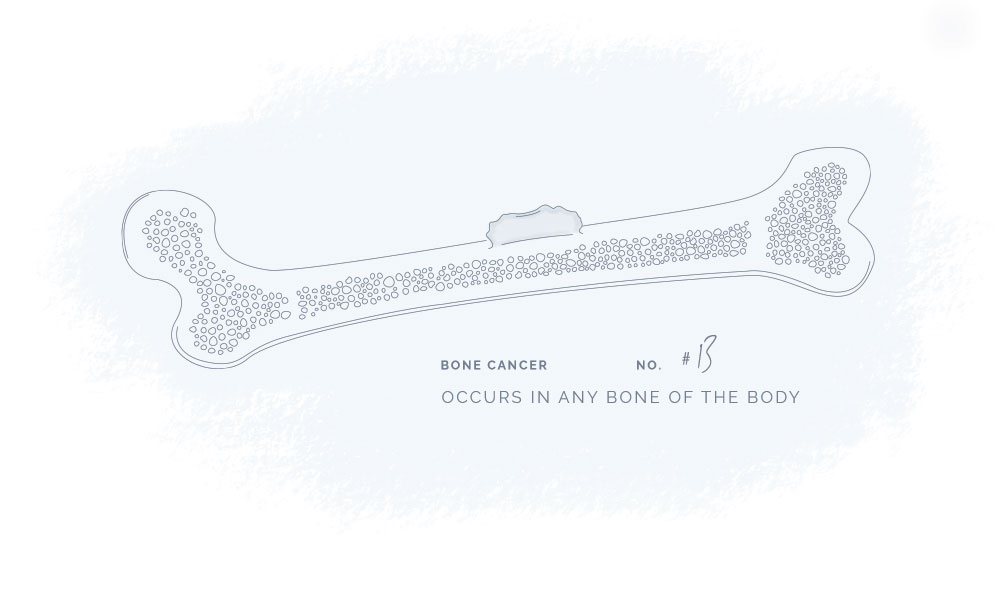Bone Cancer
Category
Cancer
REVIEWED BY
Our Biomedical Scientist
Reviewed based on
Literature Discussion
Last update
August 2020

What is Bone Cancer
Bone cancer is a rare type of cancer. It can take place in any bone in the body. Three types of bone cancer exist: osteosarcoma, chondrosarcoma, and ewing sarcoma.1
Symptoms1
- Pain in bone
- Unexpected fractures in bone (weakness)
- Fatigue
- Unintended and unexplained weight loss
Cause
The type of bone cancer depends on the type of cell where the cancer started. The most common types of bone cancer are:1
- Osteosarcoma
The most common type of cancer and is primarily found in children and young adults. Cancer starts in cells responsible for producing bones. - Chondrosarcoma
Cancer cells are involved in producing cartilage. Chondrosarcoma usually occurs in the pelvis, legs, and arms of older adults - Ewin sarcoma
Cancer develops in the pelvis, legs, or arms of children and young adults
It is not fully understood what causes bone cancer. However, factors that can increase the risk of developing bone cancer are:1
- Heredity
- Rare genetic syndrome e.g. Li-Fraumeni and retinoblastoma
- Paget’s disease of bone
- Radiation therapy for cancer
The connection between Cannabinoids & Bone Cancer
Studies find that CBD and THC may have great therapeutic potential and may be used to help treat Bone Cancer. CBD and THC are well-known cannabinoids, however, they do not have the same psychoactive effects. THC is psychoactive while CBD does not possess psychoactive effects. According to WHO guidelines, the cannabidiol CBD is generally well tolerated with a good safety profile.
In In vivo and In vitro studies, cannabinoids were found to suppress tumor growth and metastases as well as trigger apoptosis in bone cancer.3
In addition, preclinical evidence proposes that the cannabinoid THC may be beneficial in the treatment of bone cancer as cannabinoids may have anti-cancer and anti-inflammatory effects.3
The literature discussion is an overview of the published results from scientific studies investigating if and how cannabinoids can be beneficial in the treatment of Bone Cancer. The overview will be updated regularly to ensure the newest and most accurate information.
Bone cancer cells may express cannabinoid receptors useful in treatment
Research indicates that CB1 , CB2 , and TRPV1 receptors can be expressed by bone cancer cells. The inflammatory process of bone cancer cells can be affected by CB2 agonists such as anandamide or THC through modulation of Interleukin , tumor necrosis factor α and nuclear factor-κB expression , and T cell .4,5,6
This inflammatory process plays a role in pain regulation and cell death via apoptosis. TRPV1 and CB1 receptors play a role in regulating cancer pain7
Clinical trials are research studies that examine new treatments and evaluate their effects on human health outcomes.
Today, we are not able to provide any clinical trials about cannabinoids and Bone Cancer.
- https://www.mayoclinic.org/diseases-conditions/bone-cancer/symptoms-causes/syc-20350217
- Guindon, J., Et al. (2011). ” The endocannabinoid system and cancer: therapeutic implication”. https://www.ncbi.nlm.nih.gov/pmc/articles/PMC3165955/
- https://ghmedical.com/endocannabinoid-system/diseases/bone-cancer
literature - Yang, L., Et al., (2015).” Cannabinoid receptor CB2 is involved in tetrahydrocannabinol-induced anti-inflammation against lipopolysaccharide in MG-63 cells”. https://pubmed.ncbi.nlm.nih.gov/25653478/
- Lu, C., Et al., (2015).” Intrathecal Injection of JWH-015 Attenuates Bone Cancer Pain Via Time-Dependent Modification of Pro-inflammatory Cytokines Expression and Astrocytes Activity in Spinal Cord”. https://pubmed.ncbi.nlm.nih.gov/25896633/
- Hsu, S.S., Et al., (2007).” Anandamide-induced Ca2+ elevation leading to p38 MAPK phosphorylation and subsequent cell death via apoptosis in human osteosarcoma cells”. https://www.sciencedirect.com/science/article/abs/pii/S0300483X06006500
- Kawamata, Et al., (2010). ” Reduction of Bone Cancer pain by CB1 activation and TRPV1 inhibition. J. Anesth. 24, 328–332.”. https://link.springer.com/article/10.1007%2Fs00540-010-0919-0
CANNABINOIDS & RECEPTORS
Below you find the plant cannabinoids, cannabinoid receptors, and endocannabinoids that are associated with the potential therapy.
If you have any further information relevant to the connection between Bone Cancer and cannabinoids or find any of the information inaccurate, outdated or incomplete please contact us here.

